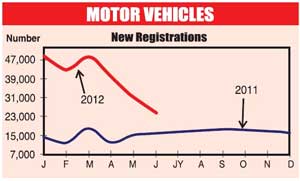12 Sep 2012 - {{hitsCtrl.values.hits}}
 hree-wheeler registrations dropped sharply from 13,753 registrations recorded last year to 4,340, while motor cycles decreased by 46.3% to 12,181.
hree-wheeler registrations dropped sharply from 13,753 registrations recorded last year to 4,340, while motor cycles decreased by 46.3% to 12,181. Whilst the wider ramifications of plunging vehicle imports on Sri Lanka’s economy, particularly its impact on government revenue, have yet to be analyzed, the impact of policy changes for Sri Lanka’s lower to middle income population is thought to be significant.
Whilst the wider ramifications of plunging vehicle imports on Sri Lanka’s economy, particularly its impact on government revenue, have yet to be analyzed, the impact of policy changes for Sri Lanka’s lower to middle income population is thought to be significant.
27 Dec 2024 9 hours ago
27 Dec 2024 27 Dec 2024
27 Dec 2024 27 Dec 2024
27 Dec 2024 27 Dec 2024
27 Dec 2024 27 Dec 2024